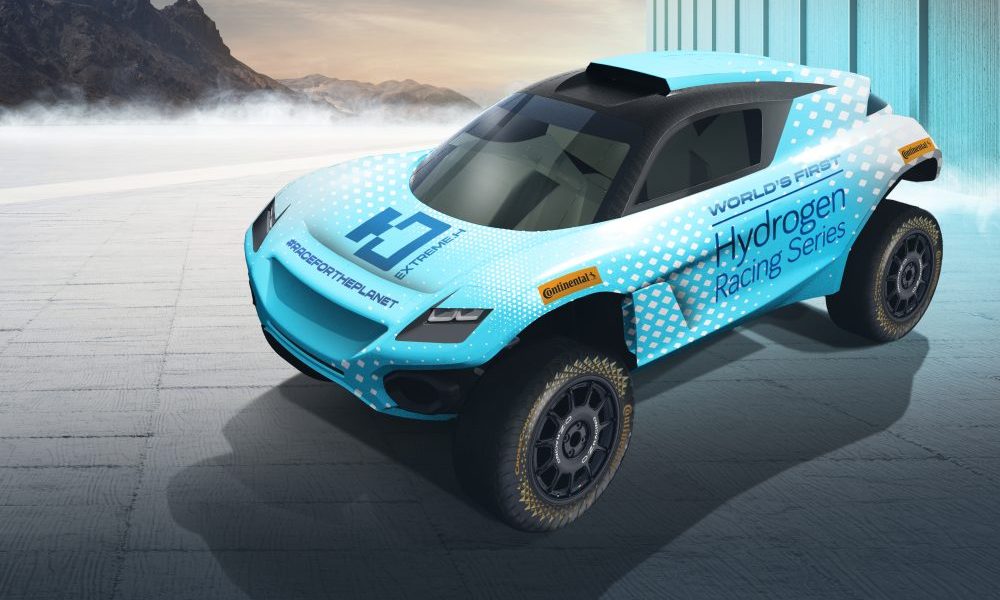The FIA, Formula 1 and Extreme H — the championship currently known as Extreme E — have joined forces to establish a joint Hydrogen Working Group.
The group will monitor the progress of the development of hydrogen technology, namely fuel cells and battery systems for vehicle applications in motorsport and wider mobility, as well as race site infrastructure, transportation, charging, storage and management, and all safety implications.
Forming the group will be representatives from all three organizations, Extreme E technical director Mark Grain, F1’s chief technical officer Pat Symonds and Nikolas Tombazis, the FIA single-seater director.
[lawrence-auto-related count=3 category=5858]
“Our sport has a tradition of bringing new technologies to the forefront of public perception in incredibly short timescales,” said Symonds. “We do this by being open-minded to all solutions and embracing cross-functional engineering. With climate change mitigation at the forefront of everyone’s mind we are committed to promoting sustainability and therefore need to explore all areas of decarbonization of the mobility sector.
“This must include sustainable liquid hydrocarbon fuels, electrification and hydrogen. This Working Group enables a collaboration which will allow us to gain first-hand experience and contribute to the understanding and development of the many aspects of hydrogen propulsion that Extreme H will embrace.”
Tombazis added: “As the governing body for both the FIA Formula 1 World Championship and the upcoming FIA Extreme H Championship in 2025, we welcome this latest collaboration.
“The FIA Technical Department has experience and knowhow in the area of hydrogen technology which we will bring to the Working Group along with sporting, safety and regulatory expertise. As is currently the case across the entire FIA motorsport portfolio, we will take learnings from this collaboration for the benefit of our sport and mobility.”
News of the Hydrogen Working Group’s formation comes after confirmation that Extreme H will have FIA championship status for its first season in 2025, before becoming a full world championship a year later.
“It’s a privilege to be working alongside Formula 1 and the FIA as we continue to develop our world-first hydrogen racing proposition,” said Grain, who is leading the development of Extreme H’s next-generation race car as it transitions to becoming the first fully hydrogen-powered motorsport series. “Our transition to Extreme H makes us the pioneers and first-ever testbed of hydrogen technology in motorsport — not only in our racing cars, but also transportation, infrastructure, refueling processes and safety regulations.
“It’s a ground-breaking initiative and we look forward to collaborating with Formula 1 and Pat [Symonds] both technically and operationally, as we continue to champion new technologies and break boundaries on behalf of motorsport, with hydrogen at the forefront.”
The formation of the Working Group, however, will not spell an imminent move to hydrogen fuel cells for F1, primarily because Formula E holds exclusive rights to create a hydrogen fuel cell single-seater series. However, there could be other benefits from Extreme E’s ongoing work that could benefit F1.
“We’re already a long way down the road with already a long way down the road with helping FIA to understand the requirements of hydrogen, but then also how we transport hydrogen,” Grain told media including RACER at last weekend’s Copper X Prix in Chile. “How we power the paddock, for example — that might be something that Formula 1 could look to move into in the future.
“I predict their plans, but we do that in harshest environments, they’ve got the benefit of tarmac and all of that easy stuff. So, that will be another opportunity, to come and look at how we run our paddock and the infrastructure that they could carry over into that world.”
Speaking of the idea behind the formation of the group, Extreme H founder and CEO Alejandro Agag said that uncertainty surrounding the best direction of the future of motorsport was a key reason for establishing a link between the burgeoning series and F1.
“My idea, or my pitch to Formula 1 was to say, listen, you don’t know which technology is going to be the one — no one knows,” he said. “For the moment they are betting on synthetic fuels, which is fine, but hydrogen is going to be one technology that could be the future, part of the equation. So why don’t we do a group in which basically, you keep an eye on it?
“So that is all that it is; there is no more, there is no less. It’s for Formula 1 to be able to keep an eye on what’s going to happen here. And what’s gonna happen here is we’re going to have the first — and I think for quite a while — the only pure hydrogen world championship racing.”
But as well as the obvious technical benefits of the collaboration, Agag suggests that Extreme E and Extreme H teams — of which several already have links to Formula 1 such as McLaren, and teams owned by the likes of F1 champions Nico Rosberg and Lewis Hamilton, and potential F1 entrant Andretti — could benefit commercially from the association.
“That’s also one of the really interesting angles of this partnership is to open commercial opportunities for our teams,” said Agag. “Some of our teams are doing OK, some of our teams are doing so-so, but to give them this unique selling point — and also for the championship itself — to have a unique selling point of hydrogen is very important. But to have the link with Formula 1 is commercially very important because there is no motorsport organization commercially stronger than Formula 1.”
